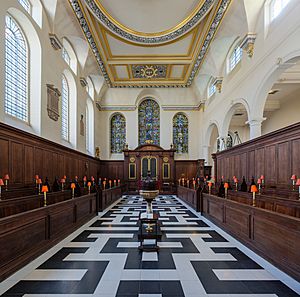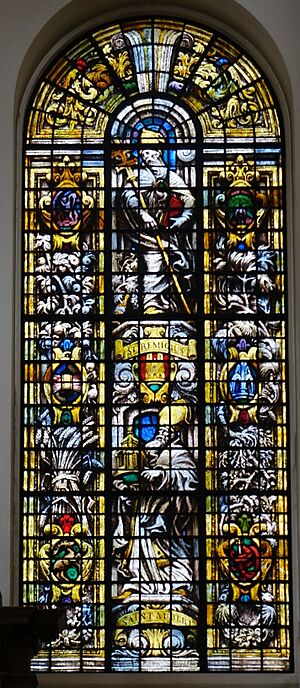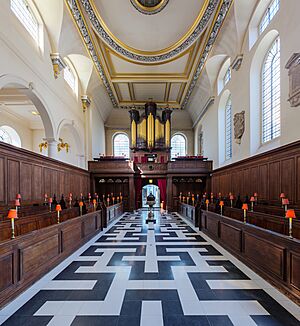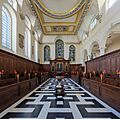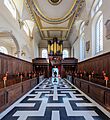St Vedast Foster Lane facts for kids
Quick facts for kids St. Vedast Foster Lane |
|
|---|---|
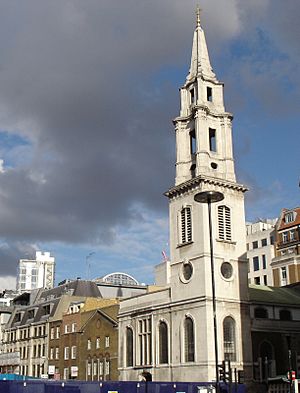
Photo of St. Vedast Foster Lane
|
|
| Location | London, EC2 |
| Country | United Kingdom |
| Denomination | Church of England |
| Previous denomination | Roman Catholic |
| Architecture | |
| Heritage designation | Grade I listed building |
| Architect(s) | Sir Christopher Wren |
| Style | Baroque |
| Administration | |
| Diocese | London |
Saint Vedast Foster Lane, also known as Saint Vedast-alias-Foster, is a historic church located in Foster Lane in the City of London. It is named after Saint Vedast, a French saint. The name "Foster" is actually an English version of "Vaast," which is how the saint is known in other parts of Europe. This saint's story came to England through connections with clergy from Augustine of Canterbury.
Contents
A Look Back: The Church's History
The first church of St. Vedast was built a very long time ago, even before the year 1308. It was repaired a lot by 1662. A famous poet named Robert Herrick was baptised here in 1591.
Rebuilding After the Great Fire
In 1666, the Great Fire of London caused huge damage across the city. St. Vedast was badly hurt, even though it wasn't completely destroyed. Because of the damage, it was chosen as one of about 50 churches that needed to be rebuilt by the famous architect, Sir Christopher Wren.
The main part of the church was rebuilt between 1670 and 1673. Workers used the old walls to help, and it cost £1,853 and 15 shillings. This made it the cheapest church Wren rebuilt in the city! Some parts of the old medieval church were kept, especially the south wall, which was found during repairs in 1992–93.
The Tower and Spire
The church's tower survived the Great Fire, but it was taken down in 1694. A new one was built from 1695 to 1698. The unique three-tier spire, which looks very fancy and "Baroque," was added later, between 1709 and 1712. It cost £2,958.
Some people think the spire was designed by Nicholas Hawksmoor, another famous architect, because his letters to the church leaders still exist. This spire was one of the last parts of Wren's city churches to be finished. The tower was built by Edward Strong the Younger, who was a friend of Christopher Wren the Younger.
Damage in World War II
Sadly, Wren's church was badly damaged again during the London blitz in 1940 and 1941. Firebombs hit it, burning out the inside. An idea was suggested to leave this church and others as roofless ruins to remember the war, but this plan was not carried out.
Bringing the Church Back to Life
After the war, the church was restored and got a new roof. This work was done by Stephen Dykes Bower starting in 1953. He worked with the new church leader, Canon Charles B. Mortlock. Famous people like Sir John Betjeman and organ builder Noel Mander were part of the church council helping with the restoration.
Dykes Bower changed the inside of the church to look like a college chapel, with seats along each side. He also made the old walls perfectly straight, so the altar now faces the main part of the church directly. He even made the pews and floor look slightly narrower as they go towards the altar. This clever trick makes the church seem longer than it really is!
He designed the beautiful plaster ceiling, which looks like it's from the late 1600s. It's decorated with gold and shiny aluminum. Pieces from other churches destroyed in the war were brought here. For example, the richly carved pulpit came from All Hallows Bread Street, and the font (for baptisms) came from St Anne and St Agnes.
Dykes Bower also asked for new stained glass windows for the East End of the church. These windows, made by Whitefriars glass, show scenes from the life of St. Vedast. They use special opaque (not see-through) glass to hide tall buildings behind the church and to make the wall look straight even though it's not. The restoration was finished in 1962.
Dykes Bower also built a small room for church meetings and a rectory (the priest's house) next to the church in 1959. Inside the rectory, there's an important painting by Hans Feibusch about Jacob and the Angel. In the rectory's courtyard, you can see a carved stone head of Canon Mortlock, made by the sculptor Jacob Epstein.
Special Features of the Church
St. Vedast is known for its small but lively steeple, its quiet courtyard, beautiful stained glass, and its richly decorated ceiling. It also has a set of six bells, which were made in 1960. The old bells were cracked during the bombing in 1941, so new ones were cast.
The Church Organ
The organ you see in the church today has a long history! It was first built in 1731 by John Harris and John Byfield for another church called St Bartholomew-by-the-Exchange.
That church was taken down in 1840, and the organ moved to its replacement church in 1841. Then, that church was also taken down in 1902. The organ then went to St. Alban-the-Martyr in Fulham in 1904, and finally, it arrived at St. Vedast in 1959.
Noel Mander restored and made the organ bigger in 1962, using the original outer case. It has one of the oldest "soundboards" (a key part of the organ) still in use in the country!
The church had other organs before this one. One was installed in 1853 and was destroyed during the bombing in 1941.
A Protected Building
St. Vedast church is considered a very important historical building. It was given "Grade I listed building" status on January 4, 1950. This means it's protected and recognized for its special historical and architectural value. The rectory next door was also listed as a "Grade II" building on July 15, 1998.
Images for kids


